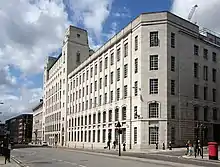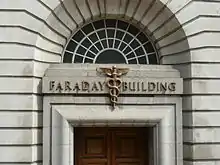Faraday Building
The Faraday Building is a building in the City of London. Because of its location, the building is a prominent feature of the London skyline despite being only 11 storeys high. The Faraday Building was the GPO's first telephone exchange in London, and is still used by BT Group. The building fronts onto Queen Victoria Street and backs onto Knightrider Street.


It started life as 'Central' telephone exchange at the Post Office Savings Bank building in Queen Victoria Street, opening for business on 1 March 1902 with just 200 subscribers. The present building, originally known as Faraday House, was designed by the architect A. R. Myers for the Office of Works and completed in 1933.[1] It was erected on the former site of Doctors' Commons, which had been the location of the Admiralty Court, Probate Court, and the principal ecclesiastical court in England.
The Post Office’s first London telephone exchange served nearly two and a half square miles (6 km2) of the capital – notable subscribers included the Treasury, the War Office and Fleet Street.
Take-up of the telephone by the public was very quick so that by 1905 the exchange capacity was extended to 10,000 subscribers, and full capacity was exhausted just three years later. To meet the growing demand from businesses in the City, a new common battery exchange was installed in 1906 with a capacity of 15,000 lines. This became 'City' exchange and officially opened in November 1907. In common with other exchanges in London, Central was able to connect subscribers to the Electrophone exchange at Gerard Street. Electrophone allowed people to listen to performances at certain London theatres and music halls while sitting at home.
In 1933, the international telephone exchange was opened at Faraday. In 1935, an automatic exchange was opened with more than 6,000 working lines. The complex task of switching subscribers over to the new exchange involved 60 engineers working for more than 15 months.
The construction of the Faraday Building obscured the riverside view of St Paul's Cathedral. This led directly to regulations protecting views of St Paul's from a number of vantage points by restricting the height of new buildings constructed in certain designated areas.[2] The City of London School and another telephone exchange, Baynard House, were built between the riverside and Faraday Building but are restricted in height to just three levels above ground.
References
| Wikimedia Commons has media related to Faraday Building, London. |
- Simon Bradley (ed.), Nikolaus Pevsner, London. 1. The City of London (London: Penguin Books, 1997) p. 343.
- John Schofield, St Paul's Cathedral: Archaeology and History (London and Philadelphia: Oxbow, 2016) pp. 110–111.
